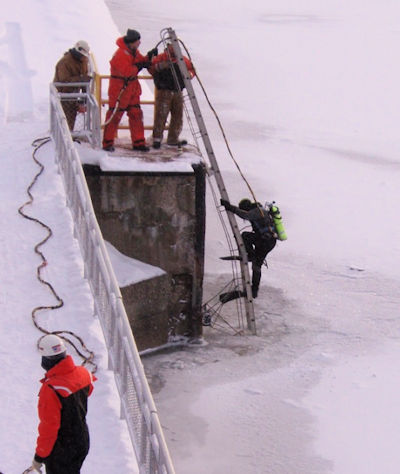30.B.08 Underwater Welding and Burning Operations.
- Underwater welding and burning must be limited to SSA (surface supplied air) mode only.
- Equipment configuration and procedures must be in accordance with the U.S. Navy
- Underwater Cutting & Welding Manual, S0300-BB-MAN-010.
- Divers performing underwater welding and burning operations must be equipped with the following as a minimum:
- (1) A rubber or neoprene dive suit in good condition that provides electrical insulation to the diver;
- (2) Insulating gloves with a cuff that, as a minimum, reaches and fully covers the wrist;
- (3) A welding/burning eye shield attached to the dive helmet with appropriate shade for the conditions at the working area.
30.C SCUBA Operations.
30.C.01 SCUBA diving operations must not be conducted:
- At depths greater than 100 ft (30.5 m);
- On dives outside the no-decompression limits unless a dual lock, multi-place, recompression chamber (capable of recompressing diver at the surface to a depth equivalent to 165 ft (50.3 m) of sea water) is available at the dive location and is immediately available for use, a trained competent operator is on site, and the chamber is of sufficient size to accommodate the diver as well as an inside tender;
- Against currents exceeding one knot;
- In enclosed or physically confining spaces;
- Using closed circuit or semi-closed circuit SCUBA;
- In visibility less than 3 ft (0.9 m) unless line tended with diver/surface two-way voice communications;
- In areas where pressure differentials exist and it cannot be positively verified that all potential leaks have been eliminated;
- When the diver does not have direct access to the surface.
30.C.02 Specific operational requirements for SCUBA operations are as follows:
- The minimum sized SCUBA tank allowed as primary air is a standard 80 ft3 aluminum tank pressurized to at least 2,700 PSI at the beginning of dive operations.
- (1) Divers must terminate their dive so that they reach the surface with a minimum tank pressure of 500 PSI.
- (2) Each diver must be equipped with a minimum 30 ft3 bailout bottle for emergency use pressurized to at least 90 percent of its working PSI rating and equipped with a separate 1st and 2nd stage regulator. An "octopus" is not considered to be an alternate air source.
- Each diver must be equipped with a buoyancy compensation device (BCD) having a manually activated inflation source, an oral inflation device, and an exhaust valve.
- Each SCUBA diver must be equipped with a submersible cylinder pressure gauge capable of being monitored by the diver during the dive.
- Each SCUBA diver must be equipped with a weight belt or assembly capable of quick release.
- Each SCUBA diver must be equipped with a depth gauge and knife.
- SCUBA air cylinders must comply with the following requirements:
- (1) Air cylinders of seamless steel or aluminum that meet DOT 3AA and DOT 3AL specifications are approved for used on USACE projects;
- (2) Each cylinder used on USACE projects must have identification symbols stamped into the shoulder of the tank; and
- (3) SCUBA tanks used on USACE projects must be visually inspected internally at least annually and hydrostatically tested at least once every 5 years in accordance with DOT and the CGA regulations; hydrostatic test dates will be stamped into the shoulder of each tank.
- A timekeeping device must be used for recording diving times for all SCUBA diving operations. When two-way voice communications are not used, each dive supervisor and diver must have a timekeeping device. When two-way voice communications are used, the dive supervisor, at a minimum must have a timekeeping device.
- Each tethered SCUBA diver must wear a safety harness with a positive buckling device, attachment point for the safety line, and a lifting point to distribute the pull force of the line over the diver's body while maintaining the body in a heads-up vertical position when unconscious or inert.
Knowledge Check Choose the best answer for the question.
30-12. In which of the following situations may SCUBA diving operations be conducted?
You forgot to answer the question!


